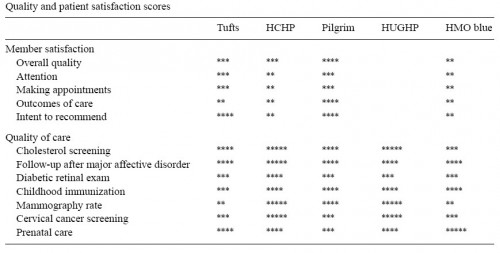What follows are excerpts of interest (to me) from sections 4-6 of Quality information and consumer health plan choices, by Nancy Dean Beaulieu (JHE, 2002).
Section 4, The Harvard University health insurance benefit (1994–1997):
The quality of care data are commonly used measures of health plan performance and are part of the HEDIS measurement set. […]
Section 5, Results:
The quality variable enters the regression as the sum of the reported quality of care measures for the employee’s plan choice. […]
If the local density of the provider network is positively correlated with plan choice in the cross-section, then one can use the percentage of individuals from a given locale enrolled in a plan in an earlier period as a proxy for the plan’s provider network. Since I have plan choice data beginning in 1994 and the zip codes of all employees in each year, I am able to construct a provider network density variable as the percentage of employees residing in a given zip code in 1994 who are enrolled in each plan. Admittedly, this network density variable is far from perfect and is likely to convey other information about the desirability of the plan to people residing in the zip code. […] [This is very clever.]
Younger (healthier?) individuals care less about specialty provider networks compared to both older individuals and younger families. Not surprisingly, families and older individuals have stronger preferences for rated quality than younger individuals.
Section 6, Discussion:
There are three central findings presented in this paper. First, following the provision of quality information, individuals enrolled in plans with lower reported quality were more likely to switch health plans than individuals in plans with higher reported quality. Second, an analysis of cross-sectional plan choices indicates that a higher quality of care rating was positively related to the probability of plan choice after controlling for other plan characteristics. Third, some employee characteristics appear to be related to plan switching costs and the relative importance of different plan characteristics. The differences in preferences between the two age groupings examined in this study should bolster the concerns of benefit managers about the likelihood and consequences of adverse selection in a multiple-choice environment without risk adjustment.



